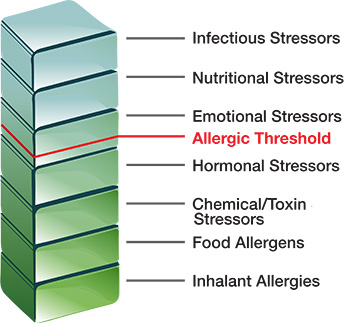The Total Allergen Load: An Explanation for Spontaneous Allergies

When I recently asked Dr. George Kroker, an allergist with Allergy Associates of La Crosse, about the importance of the phenomenon called the Total Allergen Load, he responded with, “Never have so few words had such a great impact on my day-to-day practice.”
Dr. Kroker further explained the concept with a patient who was confused about allergies that act up spontaneously. Why can an allergy sufferer feel completely fine eating dairy one day, but unable to tolerate it a month later? Dr. Kroker explained that, “Inconsistent reactions are happening because there are multiple reactions working together.”
 Dr. Kroker commonly uses a “block” analogy to explain the concept further. The analogy uses different blocks to represent the different allergies/stressors the patient is experiencing. In one example, there may be blocks for grass, dairy, pollen, and cat. The blocks stack on top of one another until the last block is stacked and the tower falls over. According to the patient in this example, the dairy allergy block caused the allergic reaction because the immune system did not begin to crash until this final block was added. However, after eating ice cream the next month, the patient has no reaction. But after mowing the lawn, the total load of blocks falls again after the one more block is added to the top of the tower. This pattern continues with allergies that seem to act up spontaneously from month to month, week to week, or even day to day.
Dr. Kroker commonly uses a “block” analogy to explain the concept further. The analogy uses different blocks to represent the different allergies/stressors the patient is experiencing. In one example, there may be blocks for grass, dairy, pollen, and cat. The blocks stack on top of one another until the last block is stacked and the tower falls over. According to the patient in this example, the dairy allergy block caused the allergic reaction because the immune system did not begin to crash until this final block was added. However, after eating ice cream the next month, the patient has no reaction. But after mowing the lawn, the total load of blocks falls again after the one more block is added to the top of the tower. This pattern continues with allergies that seem to act up spontaneously from month to month, week to week, or even day to day.
In reality, each stressor builds until the tower can no longer stand – with the last “block” (whatever stressor it may be) causing the cumulative reaction. The total load of stressors forces the patient over the allergic threshold causing them to have allergic symptoms. These stressors can include a wide range of factors beyond food and inhalant allergens including infections, nutritional stressors, emotional stressors, hormonal imbalances, and chemical/toxin stressors.
Our treatment approach includes sublingual immunotherapy to build a patient’s allergic tolerance and complementary treatments and lifestyle modifications that address the other contributing factors and reduce the overall allergic load, leading to a better overall quality of life.
Because of the wide range of factors impacting each individual, Dr. Kroker emphasized the importance of looking beyond each patient’s symptoms and considering the wide range of changing stressors that may be a factor. In short, the Total Load should be viewed as dynamic force rather than a static one because these stressors can come and go, just as symptoms do with the “sometimes allergic” patient. Once these body stressing factors are identified, there needs to be a balance between addressing each stressor impacting the Total Load while decreasing allergic sensitivities through treatment such as sublingual immunotherapy.
Dr. Kroker highlights the importance of the concept of the Total Load by stating, “In order to handle a complex allergy patient, doctors must understand the total load concept and must educate their patients so they can take proactive measures to prevent erratic allergic reactions.” Having an understanding of all of your stressors as an allergy sufferer can empower you to take control of your allergies. Adjusting diet, environment, and lifestyle factors to minimize the stressors you experience can prevent the stack of blocks from toppling and triggering another allergic reaction.
